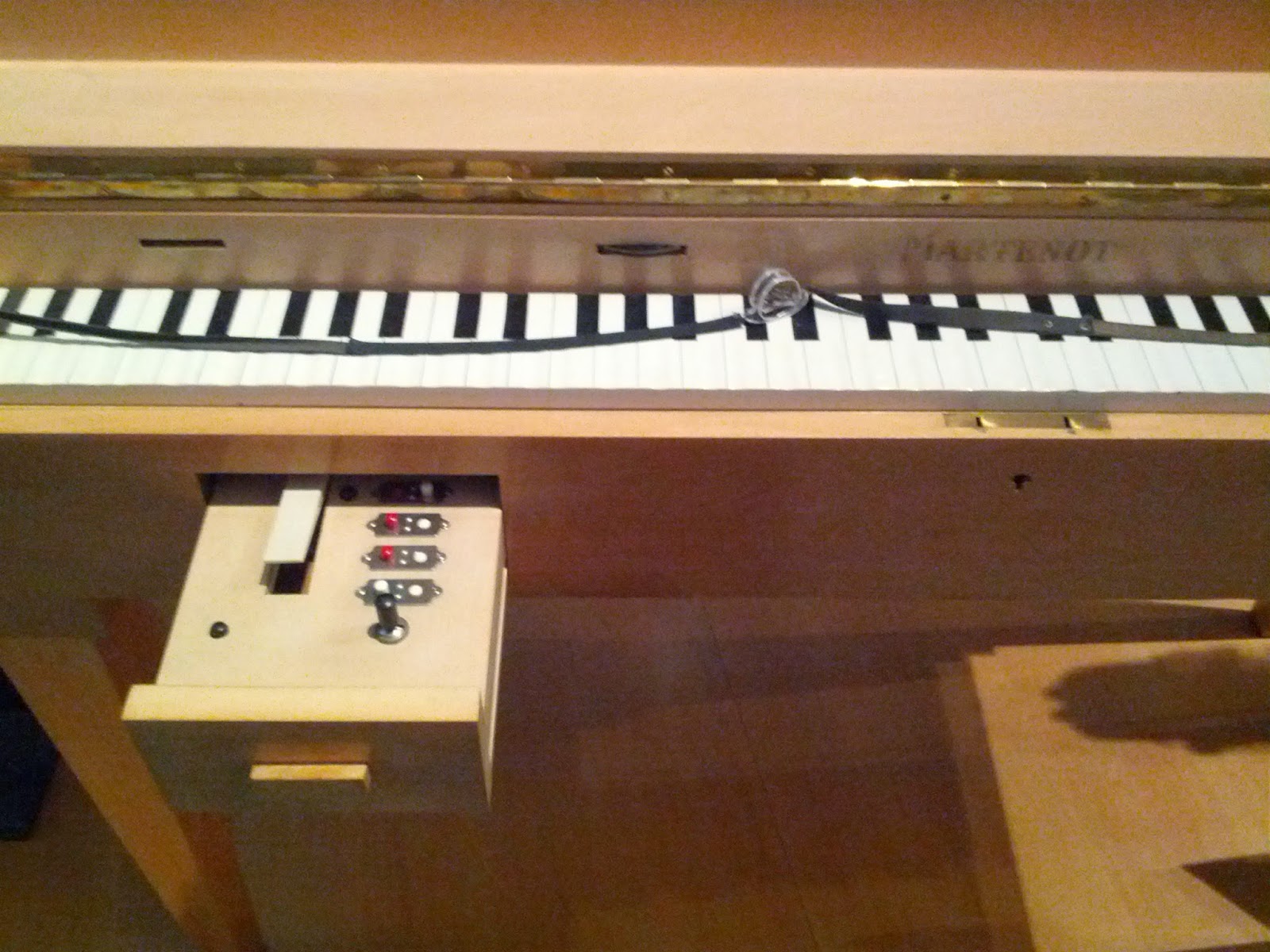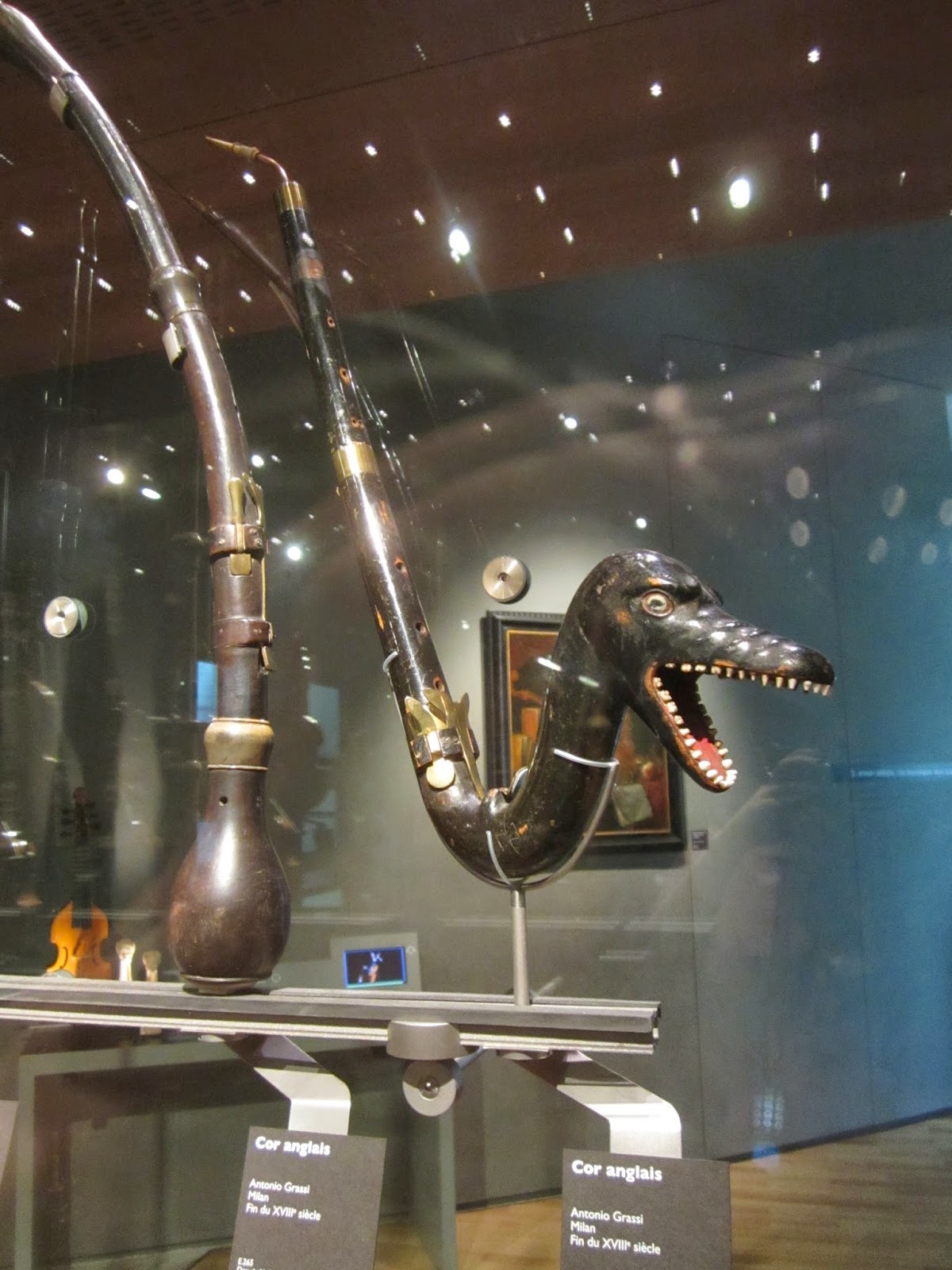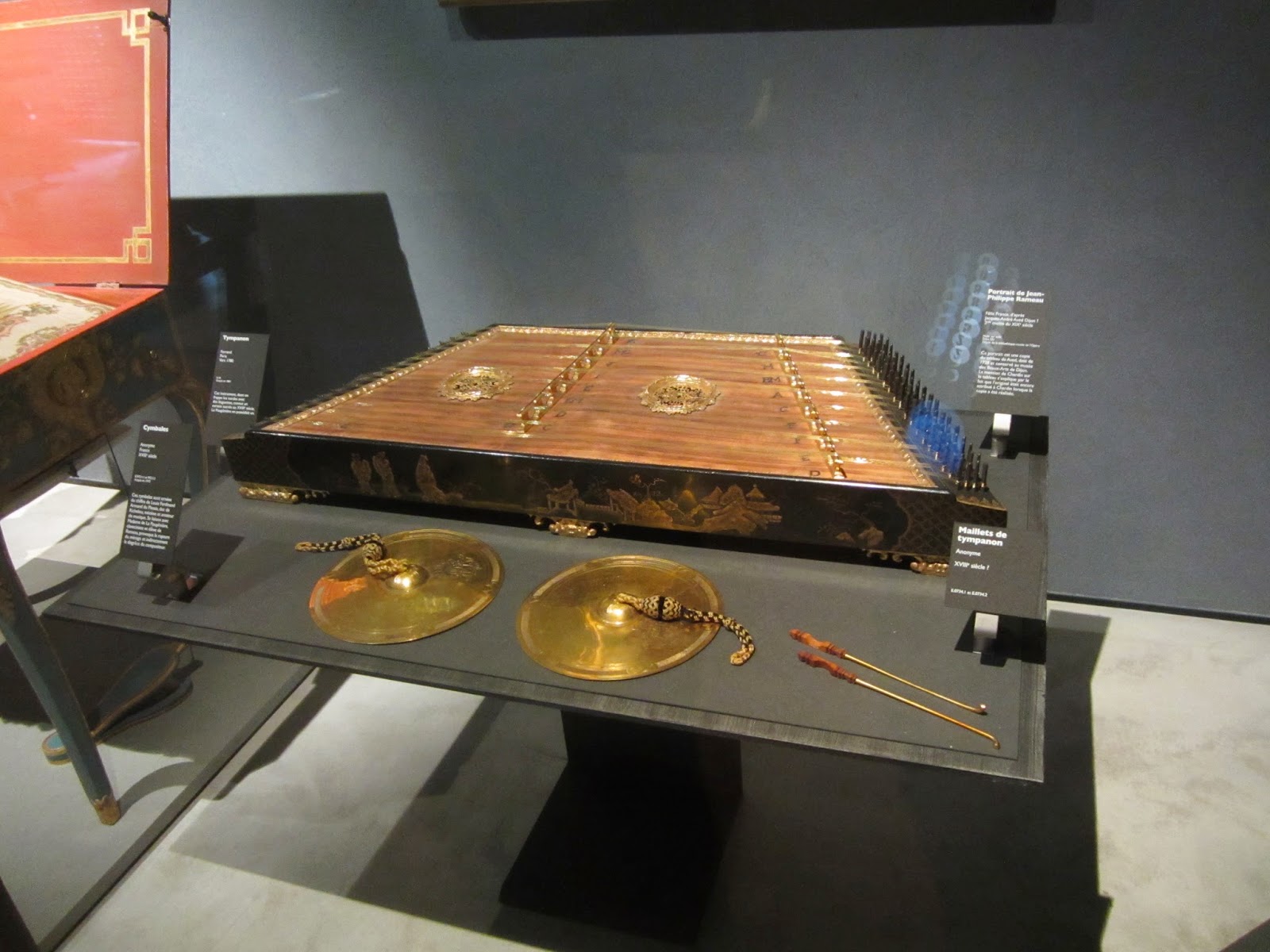When I was last in Paris, as part of my university's orchestra tour celebrating Berlioz during the summer of 2003, we spent a day at the
museum of music at the Cité de la Musique. I remember feeling like I hadn't had enough time there, and that it was really interesting, and wanted to go back. So G (a nonmusician) indulged me, and we did.

It is perhaps a little unfortunate that when we arrived at opening time, the museum strongly encouraged us to visit the temporary exhibit (currently Great Black Music) first. The exhibit is set up as a series of audiovisual experiences - a room full of plexiglass pillars on which individual artist profile videos are shown, a room of several large screens each showing different things (musical traditions in Kenya, or modern music on some island in the Caribbean, etc.), a room of TV screens where you can listen and watch performances of specific songs, etc. The overall impression I got of the exhibit was that someone had this really great idea for a video documentary series about black music, its history, its instruments, social and political influences, its musicians and the rich variety that is out there. They shot the video, did the interviews, edited together the different mini segments... and then they couldn't figure out what to cut, so gave up and rather than discard all the work they'd done, threw it at a museum instead.
Unfortunately, the exhibit was not well done. The flow from display to display was not smooth. The material was not presented in an order that made sense (history and roots of African music and how it spread around the world was done last, for example), so there wasn't a lot of context given to the information presented first. Most of the video screens had two or more videos that could be played; whoever entered the appropriate key on their audioguide first got the video they wanted - which meant that you could watch the first video several times in a row before the second video got played. In addition, if one wanted to actually watch all the videos... you'd probably need two full days to do it.
I thought the exhibit had a lot of potential - but given the backwards way in which they presented the material, it ended up feeling like a waste of time. We skipped two-thirds of the temporary exhibit (we spent almost three hours there, and the museum was only open for eight), feeling rather disappointed, and had a quick lunch of sandwiches on the grass outside, before entering the permanent collections of the museum - and
that was everything I remembered.
The museum is not so much a museum of music, as a museum showing the history of musical instruments in Europe, beginning more-or-less with when musical instruments started to be profesionally made and sold in the 16th century. It is well organized - more or less chronological, with instruments of each family grouped together within each time period, keyboard instruments placed strategically between the glass cases and a few painting showing instruments being played or made to help visualize the time periods; videos showing different aspects of the instruments, or famous works and concert halls here and there, often with a glass case showing the instrumental make-up of that work with a contemporary example of each instrument. There are places to sit placed throughout the museum (this is important when most museum-ing involves standing on your feet all day). Each afternoon, a musician demonstrates their instrument - we saw a gentleman with a dozen different sizes and types of recorders, showing us the versatility and variety available in this instrument.
There is a small section towards the end of the museum showing the evolution of electronic musical instruments, and another small section with instruments from around the world - in some cases showing us how similar instruments from different cultures can be.
The audioguide (which is included in the ticket price) is indispensable for this museum. Most of the cases had an overall explanation (information about lutes in general, for example), and many of the instruments have short audio clips one can call up in the guide as well (often recorded on that very instrument) to let us hear an example of music written for that instrument. For the most part, I stuck with the main audioguide section, but if (when!) I go back, I shall certainly listen to more of the individual instrument examples - how does this funny-looking oboe sound compared to that one?
We were a little rushed toward the end - like many museums, they started chasing people out half an hour before closing, but their method of doing so involved turning off all the videos, which, as it turns out, was probably the most interesting part of the second-to-last section of the museum (electric instruments and electronic music). The world music section (the last part of the museum) was small, so while we were a bit rushed going through there, I don't feel as though we missed much.
Dinner was a little disappointing; we went to a
burger place that was nearby (rain was threatening and we didn't want to go too far from home) that had very good online reviews. Perhaps because of the imminent rain, the place was crowded (apparently surprisingly so), and service was a bit slow (though cheerful), they got the order wrong (both for us, and the people next to us), overcooked the meat... they had the makings of a good hamburger, but the execution just wasn't there. It may be that their food truck version (which is apparently the original, the fixed-address restaurant opened later) is better, or it may be that when they are not too crowded and rushed, they are better.
Despite his mild misgivings of being a nonmusician going to a musical instrument museum, G says he was surprised at how interesting and easy to follow the main part of the museum was. So yay :)
At any rate... now for the photos! Presented in no particular order. My camera's battery ran out (admittedly, I hadn't charged it the night before because the battery indicator lied and said it was full) and I had to start using my cell phone to take pictures! Warning: There are many photos in this post. Not all of them are good pictures (lighting + glass cases + some of them taken with cell phone...). Photos are posted in more or less the order I took them in, but not always :P
 |
| Church near our apartment - currently the Musée des Arts et Métiers. I thought the one roof of yellow-green-blue shingles was amusing. |
 |
| Diorama of the City of Music. It includes libraries, concert halls, the museum, and other spaces; the museum is the vertical section above "Cité." |
 |
| Whimsical orchestra statues. |
 |
| Cornets |
 |
| A violin (baroque setup), an oboe, and a viola (presumably retrofitted into the modern style). Notice that the shape of the fingerboard, tailpiece and even bridge are different between the two. Many older instruments have been retrofitted into the modern style |
 |
| Detail of scroll of bass viol. There weren't as many crazy decorated scrolls as I thought I remembered in the museum, but there were quite a number of heads. |
 |
| Spinet |
 |
| An early guitar. Unfortunately the lighting made it difficult to photograph the amazingly intricate lace woodwork inside the hole (I wonder how this lacework affected sound quality?) |
 |
| This tiny pochette was probably less than 8 inches long. |
 |
| Baryton - a cousin to the Viola d'amore - this instrument has two sets of strings. Those which are visible from the front (on the right of the picture) and are played normally, using the fingerboard and bow. The other set of strings actually span the entire width of the extra-wide neck and are behind the fingerboard and black-and-white section. These are sympathetic strings. |
 |
| You can see the sympathetic strings on the left, with the fingered strings on the right. Also the decorative head on top :) |
 |
| Hunting horn |
 |
| Oboes with reed-making kit at bottom. The large oboe in the center is a baritone oboe. |
 |
| Folding bassoon. Rough translation by me of the information card: Patented in paris in 1872, this folding bassoon was not adopted by musicians, probably because of the difficulties of maintaining a good seal between the body pieces once unfolded. |
 |
| Crystal transverse flutes. These were made in an attempt to regulate the problems of tuning due to expansion/contraction of metal and wood flutes. Apparently the sound quality is reasonable. |
.JPG) |
| A contrabass recorder from the early 17th century. That's G holding his hand up to show how big this thing was... |
 |
| Harpsichord. A lot of these instruments had pretty amazing artwork inside. There were, if I recall correctly, three main styles of harpsichord - German, French and Flemish. This is a French specimen, with some Flemish characteristics. Don't ask me how to tell, I don't know. |
 |
| I failed to note what this instrument is called; I presume some form of organ due to the foot-pedal that runs the bellows. |
 |
| A hurdy-gurdy. I actually got to play with one a little bit a couple of years ago at a local traditional music school during an open house event. I like the French name better: Vielle à roue. |
 |
| This strangely shaped instrument is a cello. There is apparently a trapdoor on the back of the instrument to allow access to the soundpost. Fun fact: the French word for "soundpost" is âme, which means "soul." |
 |
| A number of floor harps. They range from the fairly simple fixed tone harps which cannot play everything, to the more modern lever and pedal instruments, to a chromatic harp on the end. I was running out of camera batteries at this point, so didn't take as many pictures of the beautifully ornamented and painted woodwork as I would have liked. |
 |
| And finally, the keyboard instrument has evolved into the fortepiano. |
 |
| Strads. I didn't know he made guitars, but apparently he did. |
 |
| Stradivarius' instrument molds. These was were probably for a viole d'amore and a bass viol. |
 |
| Violins, celli, a couple violas, and bows, many by famous names (Guarneri, Amati and others) |
 |
| Violin bows. These are all in the more modern style. |
 |
| Viola bows. Note the different shape of the top bows vs the bottom ones; the ones on top are more of a baroque style. |
 |
| Cello bows. I took pictures of them all because I think it's interesting to see the slightly different shapes of bows for different instruments. |
 |
| Bass bows. I believe that modern bows still come in these different styles; some bassists prefer to play with an overhand grip using a French-style bow (like for a cello bow) and others and underhand grip using a German-style bow (illustrated in this photo) |
 |
| Another. |
 |
| Serpent. Strangely called a Russian bassoon in English. |
 |
| Many metronomes. |
 |
| Finger gymnastics for virtuoso pianists. |
 |
| More gymnastics. |
 |
| This doohicky is designed to help with the suppleness of the fingers. |
 |
| This object helps the pianist stretch his fingers. |
 |
| Hexagonal piano. |
 |
| Too big to finger... it's got levers! |
 |
| Various brass instruments. I believe everything in this case (and thus all my photos down to the saxophone) were made by Sax. Some of these instruments were prototypes of the various types of saxophones, others are brass instruments of other types. The museum info placards called him Adolphe-Edourd; apparently his actual full name is Antoine-Joseph and he was called Adolphe. |
 |
| More Saxes. |
 |
| And another. |
 |
| This crazy instrument is a viola. The idea is to get more resonating surface area. |
 |
| A violin-viola. Violin on one side, viola on the other. Seems like it'd be awkward to play. |
 |
| A violin. |
 |
| Another violin. |
 |
| Irregular violin. |
 |
| Contralto. |
 |
| This goes with the Ondes Martenot. |
 |
| Somehow this instrument is played using the ring and the buttons. |
 |
| An electronic keyboard. |
 |
| Another electronic instrument... it has a keyboard... |
 |
| And this doesn't look like an instrument at all. This is a 1950s instrument, which if I understood the placard correctly, is played using pre-recorded sounds. |
 |
| An electic violin. |
 |
| Part of the string sectin of the world music display. |
 |
| Amazing artwork on this luth tamburi. |
 |
| The scroll of a Mongolian morin huur. They like horses in Mongolia. |
 |
| This charango is made out of an armadillo! |


























.JPG)






















































No comments:
Post a Comment